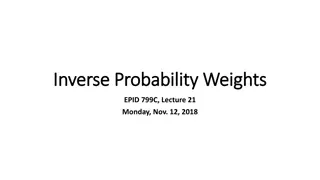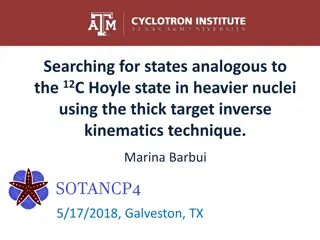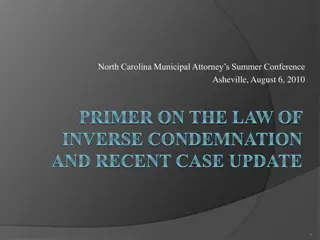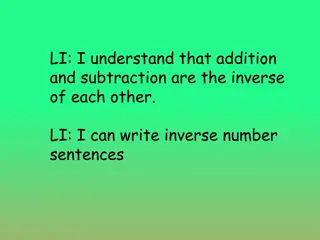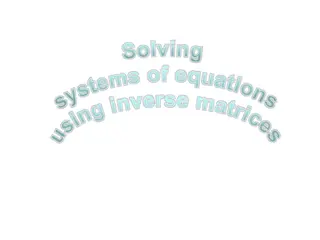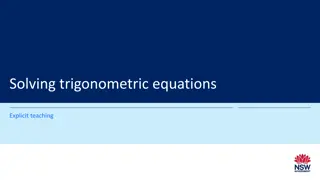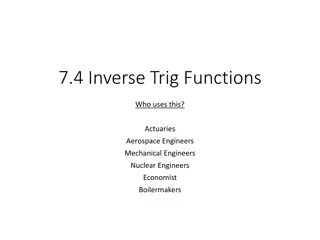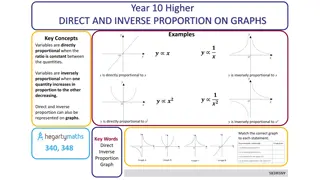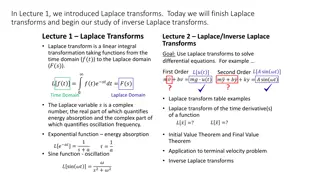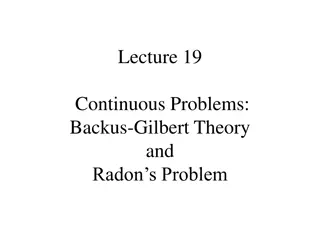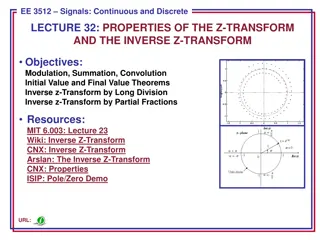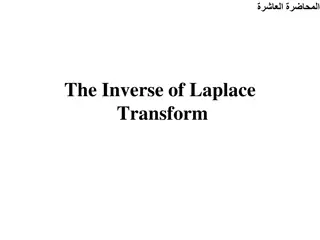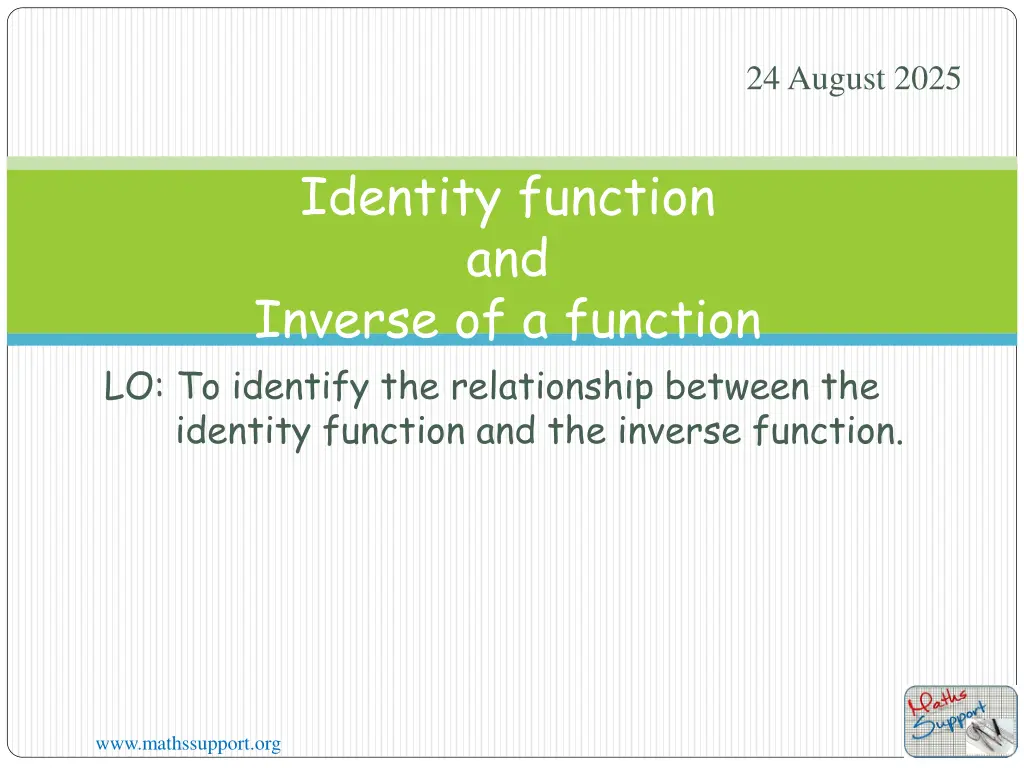
Understanding Identity and Inverse Functions
Explore the concepts of identity and inverse functions to understand their relationship and how to find inverse functions. Learn how to determine if two functions are inverses of each other by composition and solve for inverse functions algebraically. Discover the graphical representation of inverse functions and the reflection property.
Download Presentation

Please find below an Image/Link to download the presentation.
The content on the website is provided AS IS for your information and personal use only. It may not be sold, licensed, or shared on other websites without obtaining consent from the author. If you encounter any issues during the download, it is possible that the publisher has removed the file from their server.
You are allowed to download the files provided on this website for personal or commercial use, subject to the condition that they are used lawfully. All files are the property of their respective owners.
The content on the website is provided AS IS for your information and personal use only. It may not be sold, licensed, or shared on other websites without obtaining consent from the author.
E N D
Presentation Transcript
24 August 2025 Identity function and Inverse of a function LO: To identify the relationship between the identity function and the inverse function. www.mathssupport.org
Identity function A function f(x) that, when composed with g(x), leaves g(x) unchanged is called the identity function Consider the functions g(x) = 2x + 3 We are going to find f(x) such that (f g)(x) = (g f)(x) = g(x) To meet this condition f(x) must be equal to its argument x. Let f (x) = x for any x Df and g(x) = 2x + 3 f (g(x)) = 2x + 3 = g(x) g (f(x)) = 2x + 3 = g(x) So, f(x) = x is the identity function www.mathssupport.org www.mathssupport.org
Inverse function A function h that, when composed with g, results in the identity function f is called an inverse function. Function h(x) and g(x) are inverse of one another if: (g h)(x) = (h g)(x) = f(x) = x The final output is the argument x, so h(x) is a function that maps y-values into x-values, or elements of the range into elements of the domain If h is the inverse function of g, then h will reverse the action of g for all the values in the domain of g , and g will also be the inverse of h. The notation f -1(x) is used for the inverse of f(x) Note that f -1means the inverse of f ; the -1 is not an exponent (power). www.mathssupport.org www.mathssupport.org
Inverse function Consider the functions g(x) = x + 3 To find the inverse function h(x) solve the equation y = x + 3 for x, y 3 = x Now swap the x and the y y = x 3 The inverse function is Let h(x) =x 3see if when h(x) is composed with g(x) you do indeed get the identity function g (h(x)) = x 3 + 3 and h (g(x)) = x + 3 3 h (g(x)) = x g (h(x)) = x Hence, g and h are inverses of each other www.mathssupport.org www.mathssupport.org
Inverse function and h(x) =x 3, Consider the functions g(x) = x + 3 And the line y = x What do you notice? y 10 9 Graphically h(x) is a reflection of g(x) in y = x If (x, y) lies on the line g(x), then (y, x) lies on h(x). Reflecting the function in the line y = x swaps x and y, so the point (1, 4) reflected in the line y = x becomes (4, 1) So, h(x) = g-1(x) 8 y = x 7 6 5 4 g(x) = x + 3 3 2 1 x 0 -1 -10 1 2 3 4 5 6 7 9 10 -9 -8 -7 -6 -5 -4 -3 -2 8 -1 h(x) = x - 3 -2 -3 -4 -5 -6 -7 -8 -9 -10 www.mathssupport.org www.mathssupport.org
Inverse function Now consider the function g(x) = 2x + 3 To find the inverse function h(x) solve the equation y = 2x + 3 for x, ? 3 2 = x Now swap the x and the y y = ? 3 The inverse function is 2 ? 3 2 see if when h(x) is composed with g(x) you Let h(x) = do indeed get the identity function h (g(x)) = 2x + 3 3 h (g(x)) = x and ? 3 2 g (h(x)) = 2 g (h(x)) = x + 3 2 Hence, g and h are inverses of each other www.mathssupport.org www.mathssupport.org
Inverse function Consider the function g(x) Draw the line y = x y 10 9 Draw the reflection of f(x) in the line y = x 8 y = x 7 6 5 This is the inverse g -1(x) of the function g(x) 4 g -1(x) 3 g(x) = 2x + 3 2 1 x 0 -1 -10 1 2 3 4 5 6 7 9 10 -9 -8 -7 -6 -5 -4 -3 -2 8 -1 -2 ? 3 2 g-1(x) = -3 -4 -5 -6 -7 -8 -9 -10 www.mathssupport.org www.mathssupport.org
Inverse function Two functions g(x) and h(x) are inverse of each other if their composition results in the identity function f(x) = x, (g h)(x) = (h g)(x) = x The functions g and h are also said to be invertible functions. The graph of a function and its inverse are reflections of each other in the line y = x Since the inverse of a function is mapping from the range to the domain of the function, the range of a function will be the domain of its inverse, and the domain of the function the range of its inverse. Not all the functions have an inverse, only the functions that are one-to-one have inverse function www.mathssupport.org www.mathssupport.org
Finding the Inverse function Steps for Finding the Inverse of a Function Replace y with f -1(x) Make y the subject Change any x to y and any y to x Replace f(x) with y www.mathssupport.org
Finding the Inverse function Find the inverse of f(x) = x2 6x + 2if it exist, and its domain and range. Confirm your result graphically. Step 1: Replace f(x) with y Step 2: Change any x to y and any y to x Step 3: Make y the subject by completing the square y = x2 6x + 2 x = y2 6y + 2 x 2 = y2 6y x 2 + 9 = y2 6y + 9 x + 7 = (y 3)2 ? + 7= y 3 3 + ? + 7 = y Step 4: Replacey with f -1(x) The Domain for the inverse to exist: x -7 3 + ? + 7 = f -1(x) Range: y 3 www.mathssupport.org
Quadratic functions Confirm the result graphically y 10 9 8 Graph f(x) 7 6 5 4 Graph f-1(x) 3 2 1 x -10 1 2 3 4 5 6 7 9 10 -9 -8 -7 -6 -5 -4 -3 -2 8 -1 Graph y = x 0 -1 -2 -3 In order for f to have an inverse, restrict its domain to x -7, the range of the function. -4 -5 -6 -7 -8 -9 -10 www.mathssupport.org
Thank you for using resources from A close up of a cage Description automatically generated For more resources visit our website https://www.mathssupport.org If you have a special request, drop us an email info@mathssupport.org www.mathssupport.org

